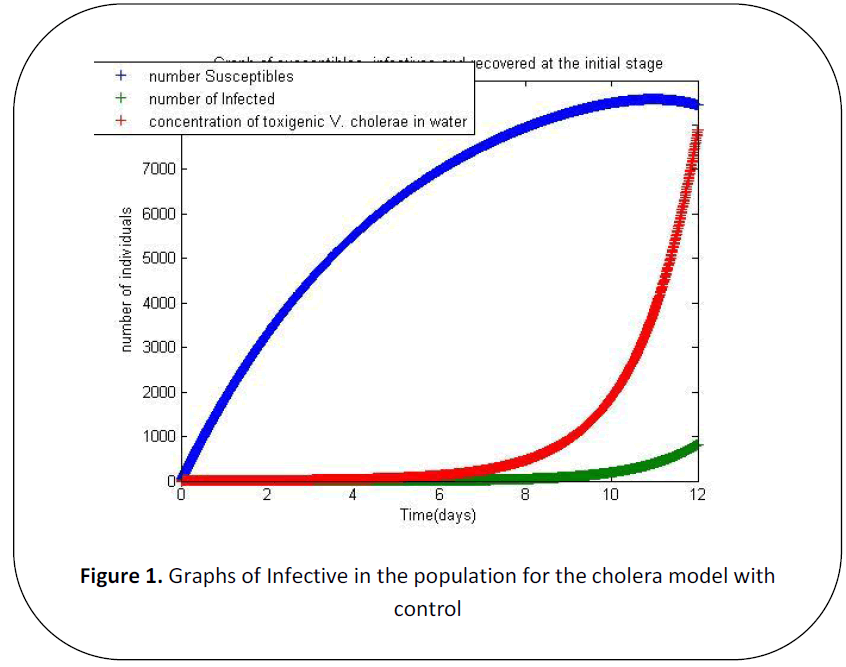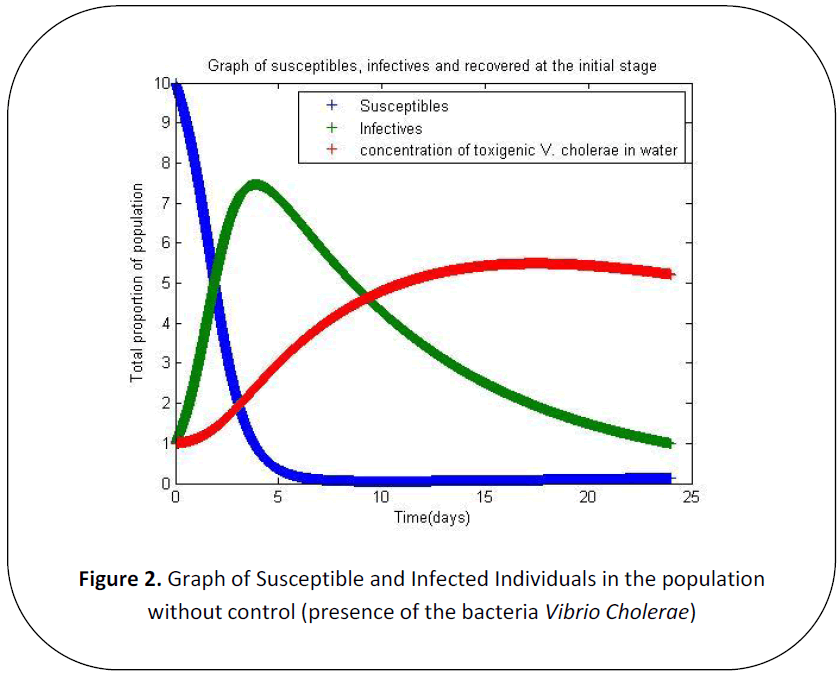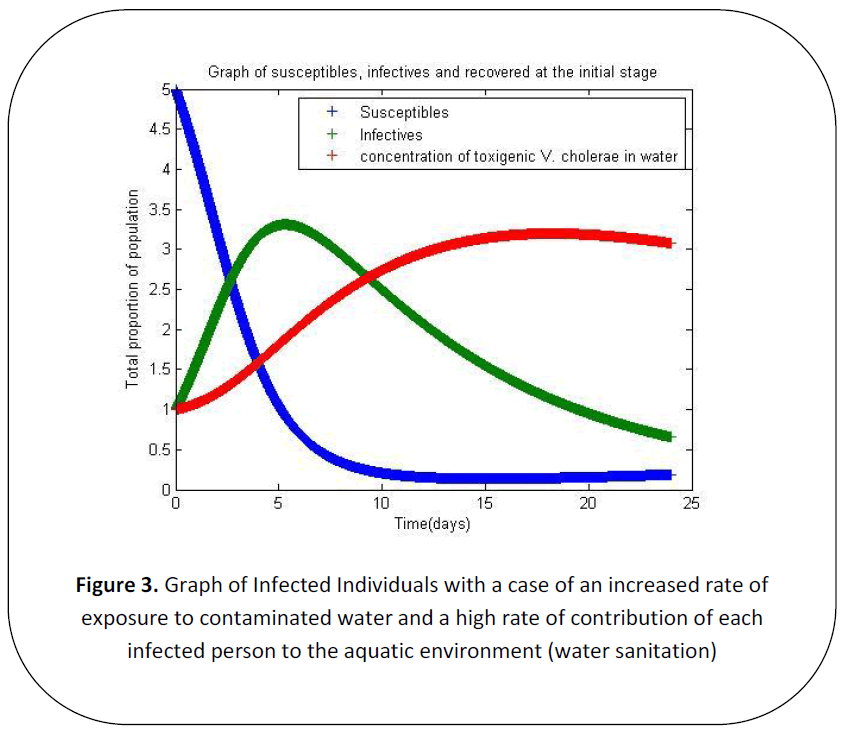Keywords
Mathematical model, Cholera, Control strategy, Epidemic, Differential equations,
Numerical simulation.
Introduction
Dynamics of a disease are a result of
the interactions of complex systems in complicated ways. The epidemiological
experiments can be difficult and expensive though, mathematical modeling is an
important tool for the understanding of their
complex dynamics [1,2]. Mathematical
modeling enables us to characterize the
general and specific behavior of these
systems analytically and to understand
which aspects contribute the most to the
observed dynamics as well as making policy
decisions for preventive measures and
control strategies.
The application of differential
equations in the transmission dynamics of
infectious diseases have been extensively
used in several papers3-8. The analysis of
these models predicted and suggested
several control strategies for the control and
eradication of the infections (diseases).
Some the control strategies being suggested
were early detection and reporting,
vaccination and mass immunization,
therapeutic treatment and good sanitation
practices. It is therefore important that
adequate attention is paid to stopping the
spread of such diseases by using effective
control strategies and measures.
Many infectious diseases are as a
direct result of poor hygienic conditions and
contact between an infectious person and
a susceptible person. Cholera, according to
reference [9], has been a persistent epidemic
and continues to be a global world health
issue. Despite the studies of this disease for
over one hundred years, it is estimated that
approximately 120,000 people die from
cholera annually [9].
Studies have attributed utmost
environmental issues for the ability of the
disease to desolate communities and
households. Cholera is an infectious disease
of which it outbreak leads to the death of
millions of individuals. The outbreak of
Cholera present a serious public health
burden in the affected regions as enormous
amount of money is needed to control and
eradicate it, and this have sparked
computational modeling efforts to forecast the dynamics of ongoing outbreaks, assess
and predict intervention strategies [10-14].
According to [15], Cholera is an acute
intestinal infectious disease caused by the
bacterium Vibrio cholerae characterized by
extreme diarrhea and vomiting. It is deadly
water – borne disease which usually results
from poor hygienic conditions and sanitation
and untreated water. The human body is
dehydrated and prevented from absorbing
liquids and this is caused by toxins produced
by the Cholera bacteria, Vibrio cholerae.
Contaminated drinking water and food are
the channels through which the bacteria are
transmitted. Individuals who are not treated
may die from severe dehydration two or
three hours of the infection and this is due to
the relatively short incubation period of the
disease (usually two to five hours), which
will eventually result into an outbreak if it is
not controlled and eradicated.
Reference [9] ascertained that,
increasing the protection against the disease
can be gained by improving sanitation and
hygiene. Though it is life threatening,
controlling and prevention is achieved if
proper sanitation practices are followed.
Most cases of cholera currently occur in
developing countries such as Peru,
Bangladesh, India and some of the coastal
regions of South America recent cholera
outbreaks. Recent cholera outbreaks in Haiti
(2010–2011), Nigeria (2010), Kenya (2010),
Vietnam (2009), Zimbabwe (2008–2009),
etc., continue leading to a large number of
infections and receiving worldwide
attention [16,17].
Currently, Ghana is faced with
prevalent cases of cholera infections,
especially in the capital Accra and it
surroundings, thereby it being declared a
health emergency and an outbreak. Records
available at the Ghana Health Service [18] have
hit a record high in the regions, with most
health centres in the various regions
recording about 300 cases daily and a weekly tally of about 1000 cases. Earlier
commemoration has it that, there were 823
cases in 2008 with no deaths; 431 recorded
in 2009 with 12 deaths; 2010 had no death
from a record of seven cases; there were
over 9000 cases with 72 deaths in 2011; in
2012, there was close to 7,000 cases with 48
deaths recorded; no deaths were recorded in
2013 out of 22 cases.2014 has at least 6,179
reported cholera cases and these figures are
rising by the day, with a total of over 67
deaths and this has called for it being
declared an outbreak.
According to reference [19],
transmission dynamics of cholera involve
multiple interactions between human host,
the pathogen, and the environment. In an
attempt to gain deeper understanding of the
dynamics of cholera, several mathematics
models have been established [20-26].
Reference [27] is of the view that,
mathematical modeling provides a unique
approach to gain basic knowledge in cholera
dynamics [13]. Effective prevention, prevention
and control strategies have been designed
based on this knowledge and the
assumptions, variables and parameters are
clarified in the formulation of the
mathematical model. These results can help
health workers understand and predict the
spread of an epidemic and evaluate potential
effectiveness of the different control
measures to be used.
There have been a number of studies
on mathematical models of cholera
transmission, but actual modeling of cholera
transmission was started by [28], they studied
the cholera epidemic which occurred in the
Mediterranean in 1973, with the proposal of
a simple deterministic model. Following
this, there were several studies, which
primarily focused on different control
strategies. Reference [29] formulated a SIR
compartmental transmission model which
divided the population as susceptible,
infected and infectious, to the other individuals. Recovered or otherwise were
removed from risk to further infection. Their
assumption was that cholera could be
transmitted through either contaminated
water or close contact with the infective
but that water borne transmission was a far
more important method of transmission.
They added a water compartment to the
model.
Other models such as that of [21], is of
a more general form which took into
consideration, the infectious stages for the
transmission of Vibrio Cholerae. The model
comprised five equations which described
the dynamics of a susceptible, infectious
and removed human population and the
dynamics of a hyper infective state and
lower infective states of Vibrio cholerae
population and also assumed that the total
population N, is constant with a constant
birth and death rate.
Ref [12] formulated a model which had
human – to – human factor incorporated into
the model. The basic reproductive number
(R0) for 2008 – 2009 cholera outbreaks in
Zimbabwe was estimated in their model.
Their model conformed to the situation in
the nature of the Zimbabwe situation that
resulted in the epidemic.
On a broader perspective, most
mathematical models of cholera
transmission on the global level have
proposed control strategy for the control and
eradication of the disease. Reference [20]
formulated a model which had an
environmental component (Vibrio cholera
concentration in water supply). The
interaction between the human host and the
environmental pathogen were studied and
analyzed in their model for the utmost
understanding of the transmission dynamics
of cholera (SIR – B, with B denoting the
concentration of Vibrio cholerae in the
water supply). Based on this idea on the
understanding of this transmission mechanic, there has been the development
of other models such as [12,21,27].
In this paper, we aim to give a better
understanding of the effects of control
measures coupled with the transmission
dynamics of cholera and this will in diverse
ways help gain practicable and efficient
preventive strategies for the control of the
cholera pandemic. Water treatment is the
most basic and fundamental strategy for
controlling cholera and it is for this reason
that we incorporate water treatment as the
control strategy in our model. Sensitivity
analysis of the parameters of the model in
the control of the cholera epidemic will be
established. Equilibrium analysis of the
disease - free and endemic states will also be
investigated for its existence and stability
and a conclusion will be drawn for the
paper.
Materials and Methods
The authors proposed a
mathematical model which will be
formulated using differential equations
based on the epidemiological compartment
modeling. We used the SIR model for this
paper, with water treatment as a control
strategy, which will be incorporated into the
model. The computer software package that
will be used to solve the differential
equation model numerically is Matrix
Laboratory (Matlab R2010a). Sensitivity
analysis and numerical simulations of the
model will be conducted.
The mathematical model
In this paper, we consider the SIR
epidemiological model with the assumption
that water treatment incorporated, is the only
control strategy, as developed in the model
ofreference [20], in addition to human birth and
death rates being unequal. For our model,
we assume that water treatment is the
control strategy because it is the basic and most primal control strategy for cholera.
With this, we introduce another
compartment into the model, i.e.
concentration of vibrio cholerae in water, at
a given time (t), denoted byC(t) .
The cholera model is a combination
of the human populations and the
environmental component (SIR – C), with
the total population, N = S + I + R assumed
to be constant. The model to be formulated
will take into consideration the effectiveness
of the water treatment as the control strategy
and will be sought for in the model. We
make the following assumptions for the
model:
• Water sanitation leads to death of the
Vibrio cholerae in the aquatic
environment.
• Water treatment is the only control
strategy considered.
• Other control strategies such as
vaccination and curative treatment were
not considered in the model.
• Human Birth and Death rate occur at
different rates.
• Cholera occurs in a relatively short
period of time and it has low mortality.
The variables and parameters used in
the model are defined below:
S(t) = The number of Susceptible
individuals at time, t
I (t) = The number of Infected individuals
at time, t
R(t) = The number of Recovered
individuals at time, t
N = Total Population
C(t) = Vibrio Cholerae concentration in the
water supply at time, t
μ = natural death rate, β = birth rate,
ε = rate of exposure to contaminated water, γ
= rate at which people recover from Cholera, m = Vibrio Cholerae growth rate, n
= Vibrio Cholerae loss rate, Ƙ=
concentration of Vibrio Cholerae in water (pathogen concentration that yields 50%
chance of getting Cholera), δ =rate of death
of Vibrio Cholerae as result of water
treatment, α= contribution of each infected
person to the population of Vibrio Cholerae
in the aquatic environment (water
sanitation), φ= net death rate of Vibrio
Cholerae, i.e. φ = m – n.
As a result of the analysis and the
assumptions, we obtained the following
dynamical systems:



With initial conditions:

In addition, we have the equation for
the R compartment (recovered individuals),
even though this equation is not needed in
the model analysis. This is
because R = N - S - I .

Analysis of the equilibrium points of the
model
In this section, we present the results
of the stability of the equilibrium points on
the model. Analytic studies on the results of
the stability of the equilibrium points were
done. In order to determine the stability of
the model, the systems of ordinary
differential equations (Equations 1 – 3) were
evaluated. The two non – negative
equilibrium points to be found are the
disease – free equilibrium, where i = 0 and
endemic equilibrium, where i = 0 .
Existence and stability of the disease –
free equilibrium
At the equilibrium point,  we therefore equate
equations (1) - (3) to zero (0).
we therefore equate
equations (1) - (3) to zero (0).


There are no infections at the
Disease – Free equilibrium, hence I = 0 . We
then substitute this into equation (7) to get

 given
given
that 
Putting C = 0 into equation (5), we
obtained  Hence there exists a
Disease – Free equilibrium point given as:
Hence there exists a
Disease – Free equilibrium point given as:
 (8)
(8)
For the stability of the Disease –
Free equilibrium, we will consider
linearizing the system of equations (1) – (3)
about the equilibrium points to prove that it
is locally asymptotically stable, by taking
the Jacobian of them.
The Jacobian matrix is given by
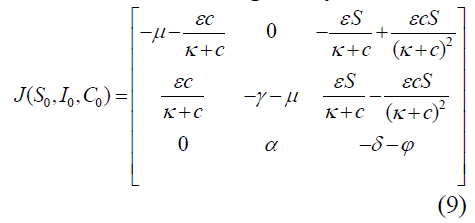
We evaluate the Jacobian matrix at
the equilibrium points,

And hence we get

The characteristic equation of the
Jacobian matrix is given as follows:
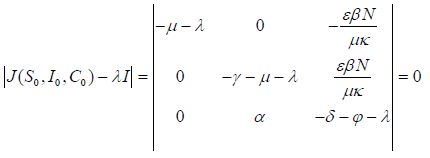 (11)
(11)

We observe that the characteristic
equation of the Jacobian matrix has three
roots.
From equation (10), 
Thus the two other roots will be
solved for using the general formula for the
roots of an equation. That
is


Where,  (12)
(12)
Note: According to [30], R0is the
Basic Reproductive Number and in
epidemiology, it’s the number of cases one
case generates on the average over the
course of its infectious period.
Now, suppose  we have
we have 
Therefore,


Hence, we can deduce from the equation ()
that
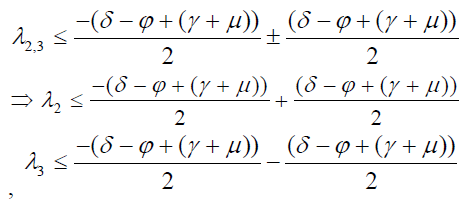
From the analysis, the roots are all
negative when R0< 1, thus the Disease –
Free equilibrium is asymptotically stable
when R0< 1.
Existence and stability of the endemic
equilibrium
The endemic state of the system of
equations (1) – (3) will be determined
at I ≠ 0. We now analyze the existence of
the stability of the Endemic state of the
model.
At equilibrium,  we
therefore equate equations (1) – (3) to zero
(0).
we
therefore equate equations (1) – (3) to zero
(0).
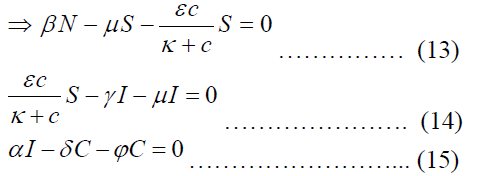
From equation (15),
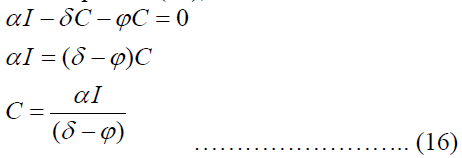
Also from equation (14),



Again, from equation (13),


We then substitute S from equation …(17)
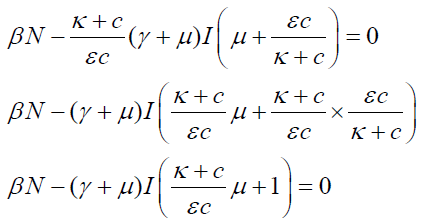
We also substitute C from equation (16)
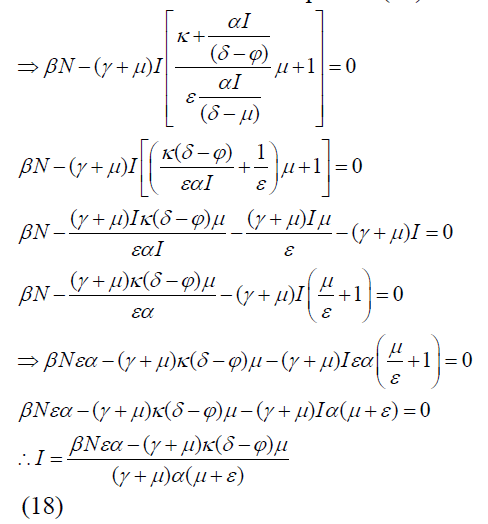
Supposedly, for I to be > 0,

Where, the Basic Reproductive
number, R0 is given as

From the analysis, it can be observed
that a positive endemic equilibrium exist if
R0> 1. This conditions (necessary and
sufficient) are true for all values of the parameters (all non – negative), hence the
endemic equilibrium is locally
asymptotically stable when R0> 1.
Numerical Analysis and Results
In this paper, we present a cholera
epidemiological model by incorporating
water treatment as a control strategy. We
used the standard ordinary differential
equation obtained from our proposed SIR -
C model to predict the dynamics and the
control of the disease. Matrix Laboratory
(Matlab R2010a) application software was
use to solve the system of equations in the
model. Numerical simulations of the model
were done, as well as the plots of the graphs.
This was done to look into the effects and
changes that will occurin the model when
the values of each of the compartments of
the model were altered. The sensitivity
analysis of the model was performed and
this led to the discussion of the existence
and stability of the disease- free equilibrium
and endemic equilibrium states of the model
equations. We assign values for the model
parameters for the components of the
compartments of the model based on
specified values as being used in the models
by references [8,20,21]. Below are the results
obtained after the numerical investigations
on the model; (See Figure 1)
Figure 1. Graphs of Infective in the population for the cholera model with
control
At the initial stages, the level of
infections is reduced since there are no
Vibrio Cholerae bacteria in the water bodies
consumed by the population. The source of
drinking water at this state is treated and
safe for human consumption. As expected,
the number of infected individuals increases
with the introduction of the bacteria in the
sources of drinking water, as it can be seen
from Figure 2.
Figure 2. Graph of Susceptible and Infected Individuals in the population
without control (presence of the bacteria Vibrio Cholerae)
In trying to access the effectiveness
of the control strategy on the susceptible and
infected individuals in the population, we
can see from Figure 1 as compared to Figure 2, that strong control strategy for the disease
generated good results for disease control
and eradication. This is due to the fact that
when the rate of exposure of humans to
contaminated water is reduced, the rate of
contribution of each infected person to the
population of Vibrio Cholerae in the aquatic
environment (water sanitation) will also
reduce and hence prevent the disease from
spreading into an outbreak.
It can be seen from Figure 3 that,
cholera cases persist in the population. This
is because the number of infected
individuals will increase and this is as a
result of the increased rate of exposure to
contaminated water and a high rate of
contribution of each infected person to the
aquatic environment (water sanitation).Even
with the presence of a water treatment as a
control strategy, cholera will still persist in
the population until both rates are reduced
drastically. This can be achieved through
sensitization and education by authorities for
the populace, on the dangers of open
urinating and defecating into sources of
drinking water.
Figure 3. Graph of Infected Individuals with a case of an increased rate of
exposure to contaminated water and a high rate of contribution of each
infected person to the aquatic environment (water sanitation)
Conclusion and Recommendations
The analysis and formulation of the
modified SIR epidemiological model with a
control strategy of water treatment (water
sanitation) incorporated (SIR – C) by the
authors enabled a better understanding of the
transmission dynamics of the spread of
cholera and how it can be controlled.
The model has two non – negative
equilibria, namely the disease – free
equilibrium and the endemic equilibrium
and their existence and stability analysis
were also performed. The analysis of the
model also produced a threshold parameter,
R0, which is the basic reproductive number.
It was noted that when R0< 1, the disease –
free equilibrium is asymptotically stable and
this indicates the disease will not persist in the population and hence can be controlled.
Also, whenR0> 1, the endemic equilibrium
state exist and become stable and this will
let the disease persist in the population and
hence an outbreak will occur. In the case
with constant controls, the equilibrium
analysis shows that the basic reproductive
number for the model plays an essential role
in determining the epidemic and endemic
dynamics of the cholera disease.
The numerical simulations analysis
was widely useful in the determination of
the effect of the control intervention on the
transmission of the disease. The control
strategy has more effect on the contribution
of the each individual to the water
ecosystem (aquatic environment) and that
there is a reduction of the rate of exposure to
contaminated and untreated water.
Cholera is a pandemic disease that
affects hundreds of thousands of people
every year. Because the bacterium that
causes cholera, Vibrio cholerae, is always
present in aquatic ecosystems, eradication of
the bacteria is not feasible. There is the
need to find better ways of treating drinking
water, predicting future outbreaks, and
treating infected individuals in the populace.
We recommend that the Government should
educate the population in order to create
awareness of the disease transmission for the
individuals to be aware of its endemism.
Health authorities and Non – Governmental
Organization (NGO’s) should sensitize the
public on the dangers of open urinating and
defecation in various source of drinking
water. Portable drinking water should be
provided for the populace so that they can
avoid the using and coming into contact
with untreated water.
Acknowledgement
The authors express their gratitude to
the unknown reviewers for their useful
comments.
Competing interests
Authors have declared that no
competing interests exist.
References
- Anderson, R. M. (1991). The Kermack McKendrick Epidemic Threshold Theorem. Bulletin of Mathematical Biology, 53(1/2).
- Anderson, R. M. &May, R. M. (1991).Infectious Diseases of Humans: dynamics and control. Oxford University Press, New York, (1991).
- Dontwi, I. K., Obeng - Denteh, W., Andam, E. A. &Obiri-Apraku, L. A. (2014). Mathematical Model to Predict the Prevalence and Transmission Dynamics of Tuberculosis in Amansie West District, Ghana. British Journal of Mathematics and Computer Science. 4(3):402-425.
- Dontwi, I. K., Obeng - Denteh, W., Andam, E. A. &Obiri-Apraku, L. (2014). Modeling Hepatitis B in A High Prevalence District in Ghana. British Journal of Mathematics and Computer Science. 4(7):969-988.
- Ahmed, B. E., Obeng – Denteh, W., Barnes, B. & Ntherful, G. E. (2014). Vaccination Dynamics of Chickenpox in Agona West Municipality of Ghana. British Journal of Mathematics and Computer Science. 4(14): 2036-2045.
- Gyasi – Agyei, K. A., Obeng – Denteh, W. & Gyasi – Agyei, A. (2013). Analysis and Modeling of Prevalence of Measles in the Ashanti Region of Ghana. British Journal of Mathematics and Computer Science. 3(2):209-225.
- Ochoche, J. M. (2013). A Mathematical Model for the Transmission Dynamics of Cholera with Control Strategy. International Journal of Science and Technology. Volume 2 No. 11.
- Wang, J. & Modnak, C. (2011). Modeling Cholera Dynamics with Controls. Canadian Applied Mathematics Quarterly. Volume 19 (3).
- Faruque, S. M., Albert, M. J. & Mekalanos, J. J. (1998). Epidemiology, Genetics, and Ecology of Toxigenic Vibrio cholerae. Microbiol. Mol. Biol. Rev., 62(4):1301–1314.
- Andrews, J. R. & S. Basu, S. (2011). Transmission dynamics and control of cholera in Haiti: An epidemic model. Lancet, 377:1248–1255.
- Bertuzzo, E., Mari, L., Righetto, L., Gatto, M., Casagrandi, R., Blokesch, M., Rodriguez-Iturbe, I. &Rinaldo, A. (2011). Prediction of the spatial evolution and effects of control measures for the unfolding Haiti cholera outbreak. Geophysical Research Letters, 38:L06403.
- Mukandavire, Z., Liao, S., Wang, J., Gaff, H., Smith, D. L. &Morris, J. G. (2011). Estimating the reproductive numbers for the 2008–2009 cholera outbreaks in Zimbabwe, Proceedings of the National Academy of Sciences, 108: 8767 - 8772.
- Tuite, A. R., Tien, J., Eisenberg, M., Earn, D. J., Ma, J. & Fisman, D. N. (2011). Cholera epidemic in Haiti, 2010: Using a transmission model to explain spatial spread of disease and identify optimal control interventions. Annals of Internal Medicine, 154(9):593–601.
- Chao, D. L., Halloran, M. E.& Longini Jr., I. M. (2011). Vaccination strategies for epidemic cholera in Haiti with implications for the developing world. Proceedings of the National Academy of Sciences USA, 108(17):7081–7085.
- McElroy, A. & Townsend, P. T. (2009). Medical Anthropology in Ecological Perspective. Boulder, CO: Westview, 375.
- Center for Disease Control and Prevention (CDC). Web page: www.cdc.gov. (2014).
- World Health Organization (WHO). Web page: www.who.org. (2014).
- Ghana Health Service (GHS) (2014). Cholera Outbreak Report in Ghana.
- Nelson, E. J., Harris, J. B., Morris, J. G., Calderwood, S. B. & Camilli, A. (2009). Cholera transmission: the host, pathogen and bacteriophage dynamics, Nature Rev.: Microbiology 7, 693–702.
- Codeço, C. T. (2001). Endemic and Epidemic Dynamics of Cholera: The Role of the Aquatic Reservoir, BMC Infectious Diseases 1(1) (2001). Retrieved from https://www.biomedcentral.com/1471- 2334/1/1.
- Hartley, D. M.,Morris, J. G. Jr. &Smith, D. L. (2006).Hyperinfectivity: A critical element in the ability of V. cholerae to cause epidemics? PLoS Medicine 3, 0063–0069.
- Alam, A., Larocque, R. C., Harris, J. Bet al. (2005). Hyperinfectivity of humanpassaged Vibrio cholerae can be modeled by growth in the infant mouse, Infection Immunity 73, 6674–6679.
- Merrell, D. S., Butler, S. M., Qadri Fet al. (2002). Host-induced epidemic spread of the cholera bacterium, Nature 417, 642– 645.
- Joh, R. I., Wang, H., Weiss, H. &Weitz, J. S. (2009).Dynamics of indirectly transmitted infectious diseases with immunological threshold, Bull. Math. Biol. 71, 845–862.
- Neilan, R. L. M., Schaefer, E., Gaff, H., Fister, K. R. &Lenhart, S. (2010).Modeling optimal intervention strategies for cholera, Bull. Math. Biol. 72, 2004-2018.
- Tien, J. H. &Earn, D. J. D. (2010).Multiple transmission pathways and disease dynamics in a waterborne pathogen model, Bull. Math. Biol. 72, 1502–1533.
- Tian, P. T., Liao, S. &Wang, S. J. (2010). Dynamical analysis and control strategies in modeling cholera. A monograph.
- Capaso, V. &Pavari-Fontana, S. L. (1979). A Mathematical Model for the 1973 Cholera Epidemic in the European Mediterranean region. Rev Epidém Santé Pub, 27:121 – 132.
- Ashliegh, R. T., Tien, J., Eisenberg, J. M., David, J. D., Junling, M. &David, N. F. (2011). Cholera Epidemic in Haiti, 2010: Using a Transmission Model to Explain Spatial Spread of Disease and Identify Optimal Control Interventions, Annals of internal medicine. 154:593- 601.
- Hethcote, H.W. (2000). The Mathematics of Infectious Diseases, SIAM REVIEW, Vol.42, No.4 Pg.599-653, Society for Industrial and Applied Mathematics.






 we therefore equate
equations (1) - (3) to zero (0).
we therefore equate
equations (1) - (3) to zero (0).


 given
given
 Hence there exists a
Disease – Free equilibrium point given as:
Hence there exists a
Disease – Free equilibrium point given as:  (8)
(8)


 (11)
(11)



 (12)
(12) we have
we have 



 we
therefore equate equations (1) – (3) to zero
(0).
we
therefore equate equations (1) – (3) to zero
(0).










